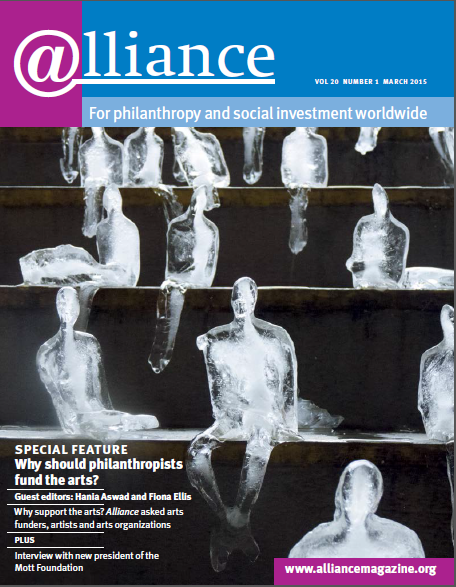There is a common assumption that innovation is usually found on the outside edges of an existing sector or industry and that startups and upstarts are the most reliable sources of new ideas. In that case, the place to look for new ideas and meaningful trends is at the edges of your immediate environment.
Six years ago I started to do this for American philanthropy and non-profits by writing what became the first Blueprint in a now annual series. Drawing from years of direct involvement in the field, the blog that I’d been writing since 2002, and my own research, I aimed to develop an independent view of the near and longer-term futures for donors and doers. The first report, Blueprint 2010, argued that impact investing and social enterprises were ‘that edge’ for philanthropy, and that charitable donors should pay close attention to what was happening out there.
This year, in Blueprint 2015, I argue that what was once at the edge – impact investing, the sharing economy, the blurring of non-profit action and political giving, and digital innovation – is now central. Digital innovation is one area where I think Americans have a great deal to learn from what’s happening around the globe. I call this the ‘Age of Digital Assumption’. We should assume that coders will create apps to help disaster respondents; that social media will be part of communications strategies; that online security is an important challenge; and that behaviours and capacities of the digital age – both promise and peril – are here to stay.
The edge is now the core. This is reflected in many ways in the Blueprint. I’m looking ever more for collaborators and informants from around the globe. I focus on the social economy and civil society – much bigger, more diverse ‘sandboxes’ than non-profits and foundations. I’m interested in all the ways we use private resources for public benefit – and all the fascinating variations on those words in different cultural, political and economic contexts.
In this new, diverse middle, the challenge is bringing old norms and established institutions into this new reality.
The model of the social economy and civil society that I use in the Blueprints is deliberately inclusive. The social economy includes tax-exempt, subsidized organizations and revenue-sustainable and financially profitable social businesses. It includes charitable funds, investment dollars and political giving (in the US, at least). It includes institutions, individuals and networks. It includes organizations whose strategies are digital through and through and those with no interest in online tools (yet they use computers and file taxes, so need to be aware of how digitized data work). Civil society in 2015 is ‘both/and’: both networked individuals and established institutions, both non-profit and commercialized, both digital and analogue.
This means we must learn to do more things. Up to this point we have isolated the new ways of working as something different, on the edge or ‘over there’. Thus do philanthropists meet separately from impact investors and social entrepreneurs claim distinction from non-profit leaders. We’ve tried to ‘duct tape’ our old processes and assumptions into new ways of working.
It’s time to accept that the edge has become the middle and develop ways of working that take best advantage of the choices while staying true to the values of civil society. This entails:
- Understanding how digital data and infrastructure work so that we can use them to advance our organization’s goals
- Finding the right mix of organizational forms and financing structures to make change happen
- Integrating digital management and governance practices into the core capacity-building efforts of all organizations
- Thinking strategically about legal and regulatory issues raised by this expanded, diversified sector. What will be the 21st century rules that best serve our goals?
If civil society is as diverse as it appears, we need to embrace those options and make them work for us. We need organizations that can manage people, money and digital assets to achieve their mission. We need to weigh the pros and cons of different financing strategies. We need to consider new practices and policies that enable individuals and communities to work towards their visions of public benefit. The values that undergird the narrower, institutional, non-profit civil society we’ve known in many parts of the world since World War II don’t need to change: free association and expression, privacy and choice are the ground floor of civil society. Our options for realizing those values have expanded, and so must our vision and our skills.
Lucy Bernholz is a research fellow at Stanford University’s Center on Philanthropy and Civil Society, where she co-leads the Digital Civil Society Lab. Email bernholz@stanford.edu
Lead image credit: Photo by Future 15







Comments (0)